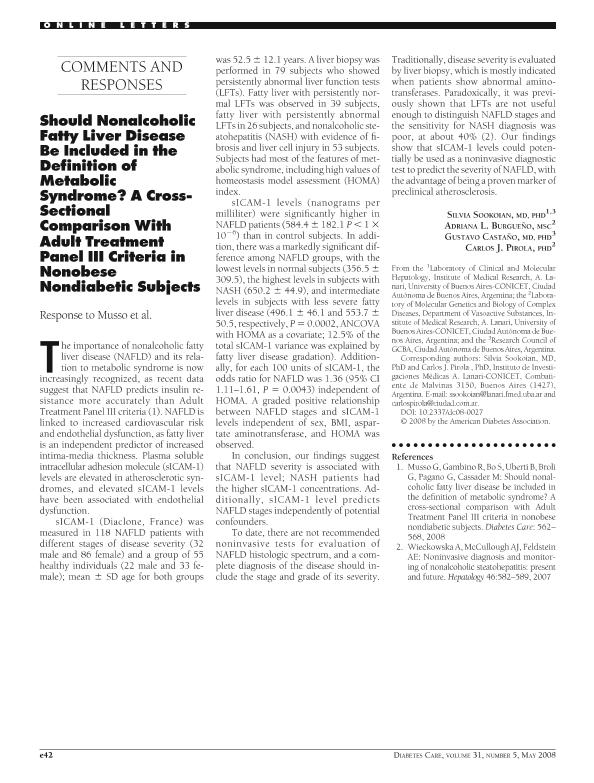Mostrar el registro sencillo del ítem
dc.contributor.author
Sookoian, Silvia Cristina

dc.contributor.author
Burgueño, Adriana Laura

dc.contributor.author
Castaño, Gustavo Osvaldo

dc.contributor.author
Pirola, Carlos José

dc.date.available
2020-05-26T18:28:04Z
dc.date.issued
2008-04
dc.identifier.citation
Sookoian, Silvia Cristina; Burgueño, Adriana Laura; Castaño, Gustavo Osvaldo; Pirola, Carlos José; Should Nonalcoholic Fatty Liver Disease Be Included in the Definition of Metabolic Syndrome? A Cross-Sectional Comparison With Adult Treatment Panel III Criteria in Nonobese Nondiabetic Subjects : Response to Musso et al.; American Diabetes Association; Diabetes Care; 31; 5; 4-2008; e42-e42
dc.identifier.issn
0149-5992
dc.identifier.uri
http://hdl.handle.net/11336/105908
dc.description.abstract
The importance of nonalcoholic fatty liver disease (NAFLD) and its relation with metabolic syndrome is now increasingly recognized as recent data suggest NAFLD predicts more accurately insulin resistance than ATP III criteria . Additionally, NAFLD is linked to increased cardiovascular risk and endothelial dysfunction, being fatty liver an independent predictor of increased intima-media thickness . Plasma ICAM-1 levels (sICAM-1) are elevated in atherosclerotic syndromes and have been associated with endothelial dysfunction. sICAM-1 (Diaclone, France) were measured in 118 NAFLD patients with different stages of disease severity (32/86 males/females), and a group of 55 healthy individuals (22/33 males/females); mean ± SD age: 52.5±12.1 years. A liver biopsy was performed in 79 patients that showed persistently abnormal liver function tests; liver specimens were scored according to the system developed by Brunt et al. Fatty liver (FL) with persistently normal liver function tests was observed in 39 subjects, FL with persistently abnormal liver function test in 26 subjects and nonalcoholic steatohepatitis (NASH) with evidence of fibrosis and liver cell injury in 53 patients. Patients had most of the features of metabolic syndrome, including high values of homeostatic model assessment index (HOMA). sICAM-1 levels were significantly higher in NAFLD patients (584.4±182.1, p<1x10-6) in comparison with controls. In addition, there was a markedly significant difference among NAFLD groups, the lowest levels in normal subjects (356.5±309.5) and the highest levels in patients with NASH (650.2±44.9) with intermediate levels in patients with less severe FL disease (496.1±46.1 and 553.7±50.5, respectively), p=0.0002, ANCOVA with HOMA as a covariate. Then, a 12.5% of the sICAM-1 total variance was explained by FL disease gradation. Besides, for each 100 units of sICAM-1, OR for NAFLD was 1.36 (95 %CI 1.11-1.61, p=0.0043) independently of HOMA index. A graded positive relationship between NAFLD stages and sICAM-1 levels independently of sex, BMI, aspartate aminotransferase and HOMA was observed. In conclusion, our findings suggest that NAFLD severity is associated with sICAM-1 levels; NASH patients had the higher sICAM-1 concentrations. Additionally, sICAM-1 level predicts NAFLD stages independently of potential confounders. To date, there are not recommended noninvasive tests for evaluation of NAFLD histologic spectrum, and a complete diagnosis of the disease should include the stage and grade of the disease severity. The ideal test is either a single or multi-marker approach to distinguish not only NASH from FL, but also to estimate the extent of liver fibrosis and monitoring response to therapy (4). Traditionally, the disease severity is evaluated by liver biopsy, which is mostly indicated when patients show abnormal aminotransferases. Paradoxically, it was previously shown that liver function test are not useful enough to distinguish NAFLD stages, and the sensitivity for NASH diagnosis was poor, at about 40%. Our findings, even though observed in a small study but with the strength of having most of the patients with NAFLD diagnosis based on liver biopsy, show that sICAM-1 levels could potentially be used as a noninvasive diagnostic test to predict the severity of NAFLD with the plus of being a proven marker of preclinical atherosclerosis.
dc.format
application/pdf
dc.language.iso
eng
dc.publisher
American Diabetes Association

dc.rights
info:eu-repo/semantics/openAccess
dc.rights.uri
https://creativecommons.org/licenses/by-nc-sa/2.5/ar/
dc.title
Should Nonalcoholic Fatty Liver Disease Be Included in the Definition of Metabolic Syndrome? A Cross-Sectional Comparison With Adult Treatment Panel III Criteria in Nonobese Nondiabetic Subjects : Response to Musso et al.
dc.type
info:eu-repo/semantics/article
dc.type
info:ar-repo/semantics/artículo
dc.type
info:eu-repo/semantics/publishedVersion
dc.date.updated
2020-05-05T16:07:18Z
dc.journal.volume
31
dc.journal.number
5
dc.journal.pagination
e42-e42
dc.journal.pais
Estados Unidos

dc.description.fil
Fil: Sookoian, Silvia Cristina. Consejo Nacional de Investigaciones Científicas y Técnicas. Oficina de Coordinación Administrativa Houssay. Instituto de Investigaciones Médicas. Universidad de Buenos Aires. Facultad de Medicina. Instituto de Investigaciones Médicas; Argentina
dc.description.fil
Fil: Burgueño, Adriana Laura. Consejo Nacional de Investigaciones Científicas y Técnicas. Oficina de Coordinación Administrativa Houssay. Instituto de Investigaciones Médicas. Universidad de Buenos Aires. Facultad de Medicina. Instituto de Investigaciones Médicas; Argentina
dc.description.fil
Fil: Castaño, Gustavo Osvaldo. Gobierno de la Ciudad de Buenos Aires. Hospital "Dr. Abel Zubizarreta"; Argentina. Consejo Nacional de Investigaciones Científicas y Técnicas; Argentina
dc.description.fil
Fil: Pirola, Carlos José. Consejo Nacional de Investigaciones Científicas y Técnicas. Oficina de Coordinación Administrativa Houssay. Instituto de Investigaciones Médicas. Universidad de Buenos Aires. Facultad de Medicina. Instituto de Investigaciones Médicas; Argentina
dc.journal.title
Diabetes Care

dc.relation.alternativeid
info:eu-repo/semantics/altIdentifier/url/https://care.diabetesjournals.org/content/31/5/e42
dc.relation.alternativeid
info:eu-repo/semantics/altIdentifier/doi/https://doi.org/10.2337/dc08-0027
Archivos asociados
